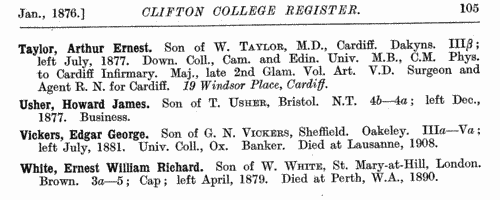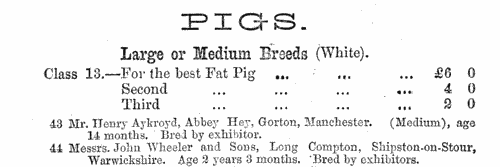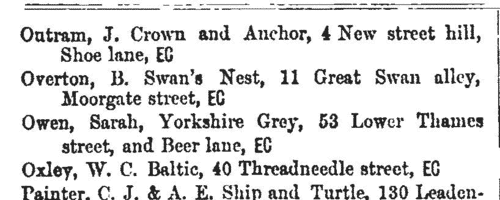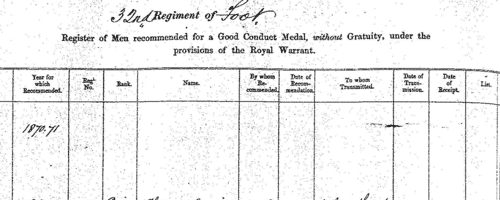Add this eBook to your basket to receive access to all 205 records. Our indexes include entries for the spelling tinsley. In the period you have requested, we have the following 205 records (displaying 81 to 90): These sample scans are from the original record. You will get scans of the full pages or articles where the surname you searched for has been found. Your web browser may prevent the sample windows from opening; in this case please change your browser settings to allow pop-up windows from this site.  Members of the British military train fighting in China
(1856-1860) Members of the British military train fighting in China
(1856-1860)
The China Medal was awarded to soldiers and sailors who took part in the prosecution of the war against the Chinese from 1856 to 1860. Separate clasps were awarded for men who had been in receipt of the China Medal of 1842; for being actually present at Canton on 28 and 29 December 1857, when that city was bombarded and finally captured; for being actually engaged in the operations which ceased with the first capture of the Taku Forts, 20 May 1858, and led to the Treaty of Tientsin; for being actually present at the capture of the Taku Forts 21 August 1860; and for being actually present before Pekin the day the gate of that city was given up to the allied (British and French) army, viz. on 13 October 1860. Among the recipients of the medals were members of the Military Train. | Sample scan, click to enlarge

| Long-stay Paupers in Workhouses: Greenwich
(1861)
This comprehensive return by the Poor Law Board for England and Wales in July 1861 revealed that of the 67,800 paupers aged 16 or over, exclusive of vagrants, then in the Board's workhouses, 14,216 (6,569 men, 7,647 women) had been inmates for a continuous period of five years and upwards. The return lists all these long-stay inmates from each of the 626 workhouses that had been existence for five years and more, giving full name; the amount of time that each had been in the workhouse (years and months); the reason assigned why the pauper in each case was unable to sustain himself or herself; and whether or not the pauper had been brought up in a district or workhouse school (very few had). The commonest reasons given for this long stay in the workhouse were: old age and infirm (3,331); infirm (2,565); idiot (1,565); weak mind (1,026); imbecile (997); and illness (493). | Sample scan, click to enlarge

| Inhabitants of Gravesend
(1867)
The Fifteenth annual edition of Hall's Gravesend, Milton and Northfleet Directory and Advertiser includes these alphabetical general directories of Gravesend, Perry Street and Northfleet. | Sample scan, click to enlarge

| Inhabitants of Bromsgrove in Worcestershire
(1868)
Gentry, farmers and traders listed in J. E. R. Kelly's Post Office Directory of Worcestershire. (The sample scan is of the section for the little parish of Hadzor) | Sample scan, click to enlarge

| Inhabitants of Dudley in Worcestershire
(1868)
Gentry, farmers and traders listed in J. E. R. Kelly's Post Office Directory of Worcestershire. (The sample scan is of the section for the little parish of Hadzor) | Sample scan, click to enlarge

| Boys entering Clifton College
(1869)
Clifton College near Bristol was established in 1862. This edition of the Clifton College Annals and Register for the Old Cliftonian Society by F. Borwick was published in 1925. Boys are listed alphabetically by term of entry, with full names, surname first, in bold. Father's (or widowed mother's) name is given (surname and initials) in capitals, and address. Then there is the name of the house (N. T., North Town; S. H., School House; S. T., South Town), first and last forms, distinctions in school work and games, and month of leaving. Where known, the editor then gave a career summary with month of death; or, if still living, address as in 1925 (in italics). | Sample scan, click to enlarge

|  Men of the 14th Regiment who fought in the New Zealand War
(1863-1870) Men of the 14th Regiment who fought in the New Zealand War
(1863-1870)
New Zealand War Medal roll for the 2nd battalion of the 14th (Buckinghamshire) Regiment of Foot: for service in the New Zealand campaign 1863 to 1867: the rolls were compiled following a general order in 1869 and the medals were distributed in 1870. The 2nd battalion, despite being part of the Buckinghamshire Regiment, was raised at Mullingar in Westmeath in 1857, and was sent to New Zealand in 1860, where it took part in the war of 1863 to 1865. In 1866 the men were sent to Australia, returning to England in 1870. | Sample scan, click to enlarge

| Exhibitors of Dogs at Belle Vue
(1874)
Manchester Fat Cattle, Poultry and Dog Show took place at the Zoological Gardens, Belle Vue, from 22 to 24 December 1874. This comprised the Second Great Annual Exhibition of Fat Cattle, Sheep, Pigs, Roots, and Corn, and the Fourteenth Annual Exhibition of Poultry, Pigeon and Dogs; for which this single joint catalogue was issued. The full names and addresses of exhibitors (and, where appropriate, breeders) were given, both in a general directory and in the detailed class lists of exhibits. The exhibits in this section were divided into pointers; bloodhounds; setters; deerhounds; greyhounds; retrievers; spaniels; mastiffs; mount saint bernards; newfoundlands; sheep dogs; dalmatians; pomeranians; bull dogs; terriers; dachshunds; pugs; italian greyhounds; king charles spaniels; blenheim spaniels; and 'other breeds'. In many cases breeders' names are also given, and these are also covered by this index. | Sample scan, click to enlarge

| Hop Merchants in London
(1874)
Henry Downes Miles compiled this London and Suburban Licensed Victuallers', Hotel and Tavern Keepers' Directory, which also had sections listings brewers, maltsters, hop factors, distillers and rectifiers of the United Kingdom. | Sample scan, click to enlarge

|  Outstanding soldiers of the 95th (Derbyshire) Regiment of Foot
(1870-1875) Outstanding soldiers of the 95th (Derbyshire) Regiment of Foot
(1870-1875)
Each year just a handful of outstanding soldiers of the regiment were chosen for good conduct medals and gratuities: these are listed here. There were two lists, one for men recommended for the Good Conduct Medal without a gratuity, and one for gratuities - £5 to a private, £10 to a corporal, and £15 to a serjeant. Both lists are indexed here, and each gives rank, name, regimental number, date of recommendation and date of issue. (The sample scan is from the 32nd foot). The regiment returned from India in 1870. | Sample scan, click to enlarge

|
Research your ancestry, family history, genealogy and one-name study by direct access to original records and archives indexed by surname.
|












